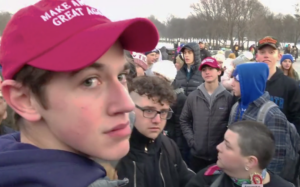
Still from ‘The Boys in Red Hats,’ Shark Dog Films
The Boys in Red Hats (2021) is about the 2019 encounter between field-tripping students from an all-boys Catholic school and a small Native American group on the steps of the Lincoln Memorial. The film is worth a watch, not the least because it is a mess of confused sympathies.
Director Jonathan Schroder explains at the start that his recent work has been about a rural veterinarian. This is an understatement so large we are forced to remember it when, later, he says he despises others’ lies, especially those of Nathan Phillips, the Omaha man drumming and singing in that encounter. But it lets Schroder explain why he would do something as unthinkable (to him) as to make a documentary about the wealthy, White, MAGA-hat wearing boys of Covington Catholic: he is an alum of that high school.
I thought at first that Schroder was using insider sympathies as a rhetorical sleight-of-hand to engage the Right. Then I wondered if his attempt to sweet-talk his way in had gotten out of control. Then I wondered if he was afraid of parents, lawyers, and other people he knew back home. In the end, I felt that what the film’s best impulses condemn is the thing wrong with it.
Schroder often reveals himself in the film to be of the “tribal” mentality of the “elite” of that “insular” community (all words used by the film), and less alarmed by the behavior of the boys that day than by how the incident blew up in the media. He attributes his reaction to the “complex” nature of the event, which was not exactly as the first video clips portrayed on social media. (The boys are often said to have been “exonerated.”)
Schroder used to play for the “CovCath” football team, “the Colonels.” His team spirit is still high. “I’m a part of that community, I’m a part of that culture,” he says. He goes to some lengths to explain the chants, tomahawk chops, face/body painting (including blackface), thrashing, and mockery (which is class- and racially-motivated) that the boys do at sporting events, and how the same chants and thrashing should not be seen as a cause of the incident at the Lincoln Memorial.
Schroder does reflect on his loyalty to CovCath, explaining that he was a victim of the school, mocked and alienated by wealthier peers, and punched in the face by a popular teacher during class. By the end he makes his peace with his abuser and, it seems, with the school’s brutalizing traditions, its extended “family,” and self-styled good intentions.
“I love CovCath now,” Schroder told the Cincinnati Enquirer in 2019. “If I can make something positive out of this situation [with my documentary], I feel like I will have succeeded.”
“Complex,” once entered into, is not escaped with pat solutions.
The film devotes many minutes to Native-American and other Phillips-sympathetic interviewees, who make good points, but those do not seem to jibe with Schroder. The confusion in the documentary lies in how his agenda clashes with another force in the production that has better instincts. I suspect that force is the Supervising Producer, Justin Jones, who is shown on-camera acting as a conscience for Schroder.
At one point, for instance, Schroder compares himself to the CovCath boys, as if justifying their behavior. “If you’re a White guy like me it can be difficult to relate to minorities, especially if surrounded by other White people,” he says. Jones has to explain that this will not convince everyone.
In other sequences, Schroder worries over getting Nick Sandmann, the 17-year old with the “smirk heard ‘round the world” (as the film’s promotional copy calls it), and Nathan Phillips to agree to interviews. Both subjects are “hard no’s.”
Schroder says that since Sandmann is a minor, it would be “a bad look” to go knocking on his door unexpectedly. Justin Jones softly warns that he hopes Schroder will afford Nathan Phillips the same humanity as Sandmann. Instead Schroder aggressively repeats that Phillips has lied “many times” (the military service he claimed seems to have been debunked, eg) and says he has many more questions for Phillips than he does for Sandmann.
Schroder and crew then drive five hours to surprise Phillips at home with a gotcha interview. Phillips does not want to talk and says he will call the police if Schroder does not leave. Schroder, like a spoiled kid denied, is so enraged that he looks as if he will cry. He exaggerates that Phillips “slammed the door in my face” and comments on Phillips’ living conditions in a scornful manner.
Meanwhile, the film often works to contextualize who holds the power and privilege in this event. There is only one person, as someone in the film says, whose family hired image consultants and lawyers to sue NBC and other media companies for hundreds of millions of dollars (and won, in some cases, for undisclosed sums): Nick Sandmann. Nathan Phillips says he does not have health insurance and hopes to be eligible for food stamps.
Covington Catholic, one interviewee says, has had only one African-American teacher in its 50-year history, and the kids never see diversity or poverty except on “mission trips” where they believe themselves saviors. An interviewee says the boys are taught that “God roots for the Colonels.”
Another alum declined to be interviewed for the documentary but told Schroder, “I love my bubble.” Schroder says he is bothered by that but then tries to claim that the real problem in America is the insularity bred by social media, Fox, and CNN. He offers these words of wisdom: “Maybe it’s time we all burst out.”
The song that plays over the end credits is a Randy-Newmanish ripoff co-written by Schroder, with pablum lyrics about “red, white, and blue diversity,” and “let’s be friends.” The documentary has plenty of lessons to offer, but Schroder did not learn them.
